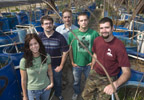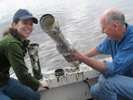Graduate students using CREST funds to study wetlands restoration
Contact: Rene Abadie
3/29/07
Click on thumbnail for high resolution photo
(1) (2)
(2)  (3)
(3) 
Captions ...
(1) CREST SCHOLARS -- Southeastern Louisiana University’s four CREST Scholars gather in the university's mesocosm located in the horticultural center. From left, are Aine Johnson, Christopher Harris, Southeastern biologist Gary Shaffer, Chris Lundberg and Eddie Koch.
(2) COLLECTING SAMPLES – Southeastern Louisiana University CREST Scholar collect samples in the Maurepas Swamp.
(3) MEASURING CYPRESS GROWTH – Southeastern Louisiana University graduate student and CREST Scholar Chris Lundberg and student assistant Scarlett Vallaire record measurements of cypress seedlings in the Maurepas Swamp.
HAMMOND -- Four Southeastern Louisiana University graduate students are literally knee deep in research projects that are addressing the loss of crucial Louisiana wetlands.
Selected as CREST (Coastal Restoration and Enhancement through Science and Technology) Scholars, the students have been provided funding to research the most effective approaches to restoring Louisiana’s vanishing coast.
Edward Koch of Ponchatoula, Christopher Lundberg of Albany, Aine Johnson of Lake Charles and Chris Harris of Bogalusa are all working on their master’s degrees in biology or microbiology and conducting intensive field research under the mentorship of Southeastern biologists Gary Childers and Gary Shaffer.
Their projects range from a study of the best environments that promote the healthy growth of marsh vegetation to the benefits of using treated sewage effluent to convert marsh and open water into cypress-tupelo swamps that can help decrease storm surges.
The projects funded by CREST, an alliance of a dozen Louisiana and Mississippi universities, are intended to add to the body of research and best practices to help policymakers, planners and coastal resource managers use the latest science to ensure productive coastal habitats. Funds are provided by the National Ocean Service of the National Oceanic and Atmospheric Administration.
“Restoration of our coastal wetlands has never been more important or urgent,” said Daniel McCarthy, dean of the Southeastern College of Science and Technology. “The alarming rate of loss of coastal wetlands that Louisiana experiences annually has been well documented. The hurricanes of 2005, which demolished 218 square miles of wetlands, can be considered a wake-up call for the potential for even greater devastation if we cannot restore the buffer zone against storms that the wetlands can provide.”
Two projects are evaluating the optimum environments for the growth of baldcypress trees, the species that once dominated the wetlands of the southeast but which decreased greatly in number due to extensive lumber harvesting and wetlands deterioration.
Koch has retrofitted the university’s mesocosm facility, an experimental system that simulates the real-life conditions that exist in Louisiana wetland systems. He is using the Maurepas Swamp as his model, “because it experiences the entire range of environmental and human impacts felt by wetlands throughout the state, ranging from hurricanes and salt pulses to droughts and river diversions,” he said.
In the mesocosm facility, Koch plants trees, shrubs, grasses and herbs common to the Maurepas Swamp in 144 different vessels. He is able to selectively control an array of environmental conditions, such as water level, water flow rate, nutrient presence and salt level.
“With this approach, I can simulate the entire Maurepas Swamp, how it exists now and how it might exist with a fresh water river diversion flowing through it,” Koch said. The swamp is a candidate for a future Mississippi River diversion project designed to mimic the healthy natural flooding that existed prior to the implementation of extensive levee and flood control systems that have been installed over the last century.
Lundberg is trying to determine how treated sewage effluent can stimulate the growth and productivity of baldcypress seedlings. More than 5,000 seedlings, each outfitted with plastic tubing to keep pesky nutria from gnawing at the plants, are being planted in nearby Four Mile Marsh, a 700-acre site that receives over four million gallons of treated sewage every day. His approach has the potential to grow cypress trees more than twice as fast as traditional plantings with far higher chances of survival.
The city of Hammond has a new sewer treatment system that discharges treated wastewater into an area bordering the Joyce Wildlife Management Area (JWMA) near Ponchatoula.
“Wetlands are often used as a tertiary treatment for sewage effluent,” Lundberg said. “It’s a win-win situation: the wastewater provides the wetlands with nutrients for accelerated growth and, in turn, the wetlands cleanse the water.”
Lundberg said the information will help policymakers make decisions about wastewater treatment, wetlands restoration, and hurricane protection. “The information stands to provide evidence to other municipalities of the benefit of using the wetlands as a form of tertiary sewage treatment,” he added. “It should demonstrate to the public that areas in coastal Louisiana that were historically swampland can be restored through the wise use of fresh water sources.”
The other two projects – under the mentorship of Childers – are analyzing the microbial transformation of the chemicals and nutrients introduced by the effluent into the system through analysis of ground water, soil sediments, surface water and effluent samples.
“By analyzing these chemical levels and transformations, we can determine the impact of the introduced effluent on the system,” Childers explained. “From a management standpoint, it is critical to understand this so that everything is transformed into something that will not harm the environment.”
Johnson is attempting to determine the amount of organic matter that’s delivered into the JWMA and how the microbes alter the material. She is using several techniques ranging from chemical and nutrient analysis to DNA examination of the microbial community. Microbes are the base of the food chain and essentially support the entire system, she explained.
“Microbes change the effluent into a more useable form for organisms,” she said. “This increases the overall health of the system and allows the marsh to be used as the tertiary treatment for wastewater. This will not only save the city of Hammond a lot of money, but will also allow more plant growth, hopefully resulting in accretion.”
Using an analysis of soil, water and gas emissions, Harris is evaluating the effects that the pretreated wastewater. He is studying the role bacteria play in the nutrient cycling.
“Microbes transform nutrients into substances that are used by plants and animals,” Harris explained. “During this transformation, gasses are produced that can impact the environment.”
He is collecting and analyzing the soil, water and emissions of gas before and after the introduction of the effluent into the area. “Theoretically, the effluent should provide a steady supply of water and nutrients to allow a large increase in the microbial community, which will increase the nutrients available for larger organisms such as plants and animals,” he said. “This should result in an increased production of plant life that can help fight saltwater intrusion and potentially lead to more land development.”
“These fellowships have enabled our students to greatly strengthen their graduate research,” said Shaffer. “In general, graduate-level research fellowships allow a student to serve as the principal investigator of a grant and this adds a higher level of responsibility to their research. It also gives them valuable experience in developing the skills of grantsmanship, a crucial aspect of conducting good science.”
More News...
